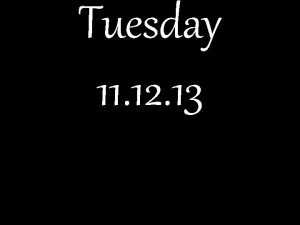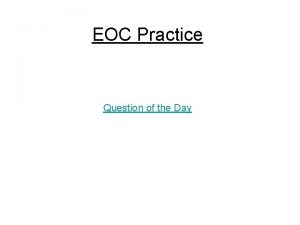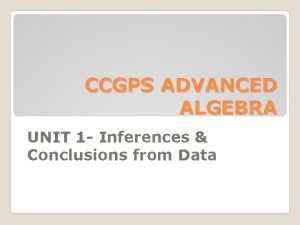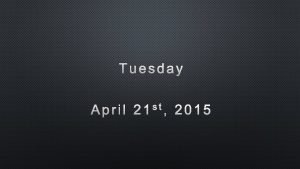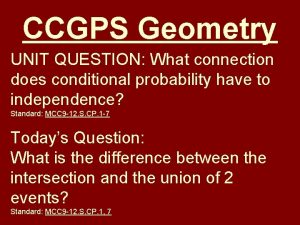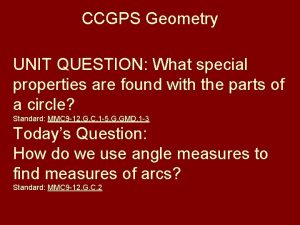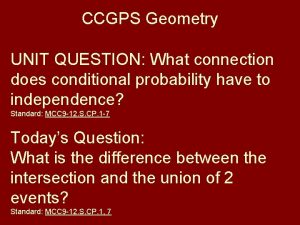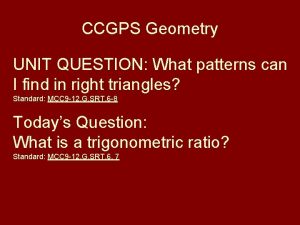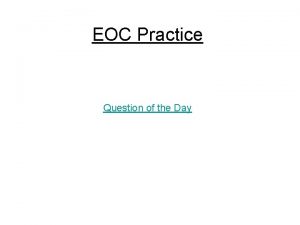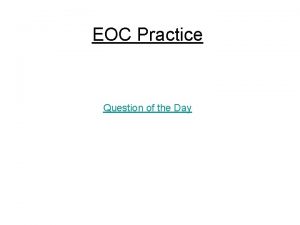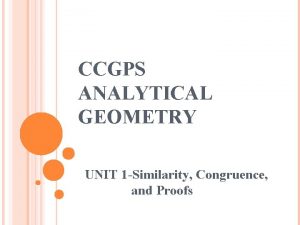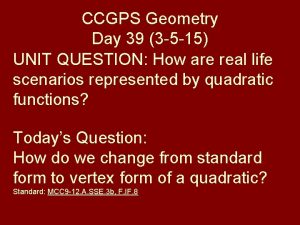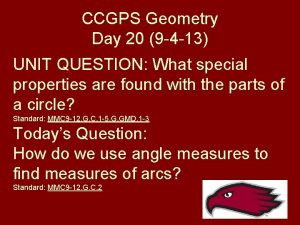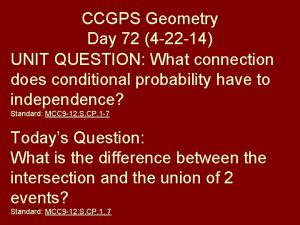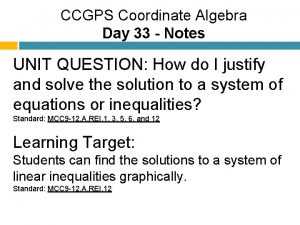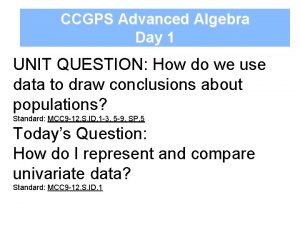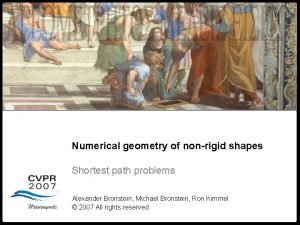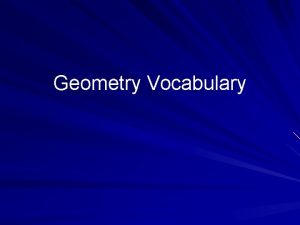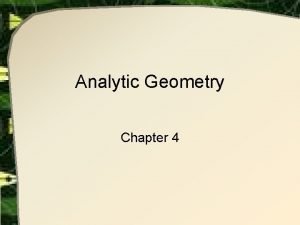Tuesday 11 12 13 CCGPS Geometry UNIT QUESTION


























- Slides: 26

Tuesday 11. 12. 13

CCGPS Geometry UNIT QUESTION: What connection does conditional probability have to independence? Standard: MCC 9 -12. S. CP. 1 -7 Today’s Question: What is the difference between the intersection and the union of 2 events? Standard: MCC 9 -12. S. CP. 1, 7

Compound Probability A compound event combines two or more events, using the word and or the word or.

AND Means you MULTIPLY

OR Means you ADD

Mutually Exclusive vs. Overlapping If two or more events cannot occur at the same time they are termed mutually exclusive. They have no common outcomes. Overlapping events have at least one common outcome.

Mutually Exclusive Events For mutually exclusive events, the probability that one or the other of several events will occur is found by summing the individual probabilities of the events: P(A or B) = P(A) + P(B) A Venn diagram is used to show mutually exclusive events.

Mutually Exclusive Events Example 1: Find the probability that a girl’s favorite department 0. 45 store is Macy’s or Nordstrom. Find the probability that a girl’s favorite store is not JC Penny’s. 0. 90 Macy’s Saks Nordstrom JC Pennys Bloomingdale’s 0. 25 0. 20 0. 10 0. 25

1 2 3 4 5 6 7 8 9 4 5 6 7 8 9 10 11 12

Mutually Exclusive Events Example 2: When rolling two dice, what is probability that your sum will be 4 or 5? 7/36




Mutually Exclusive Events Example 3: What is the probability of picking a queen or an ace from a deck of cards 2/13

Overlapping Events Probability that non-mutually exclusive events A and B or both will occur expressed as: P(A or B) = P(A) + P(B) – P(A B)

Intersection of 2 Events Denoted by the symbol: A B Is the event containing all elements that are COMMON to both A and B This is an AND probability!

Overlapping Events Example 1: Find the P(A B) 29/48

Overlapping Events Example 2: Find the probability of picking a king or a club in a deck of cards. 4/13

Overlapping Events Example 3: Find the probability of picking a female or a person from Florida out of the committee members. Fem Male FL 8 4 AL 6 3 GA 7 3

1 2 3 4 5 6 7 8 9 4 5 6 7 8 9 10 11 12

Overlapping Events Example 4: When rolling 2 dice, what is the probability of getting an even sum or a number greater than 10?

Complementary Events The complement of an event is the set of outcomes in the sample space that are not included in the outcomes of the event. The complement is denoted with the word “not, ” or with the ' or symbol. What is the probability not being in the band or a club? 1 - 29/48 =19/48

Complementary Events What is the probability that a female does not play volleyball? 1 - 26/454 = 214/227

Class Example A = people in a Science Class B = people in an English Class A B


 Mutually exclusive definition
Mutually exclusive definition Ccgps analytic geometry
Ccgps analytic geometry Ccgps geometry
Ccgps geometry Ccgps geometry
Ccgps geometry Costa questions level 2
Costa questions level 2 Ccgps advanced algebra
Ccgps advanced algebra Electron geometry and molecular geometry
Electron geometry and molecular geometry 4 electron domains 2 lone pairs
4 electron domains 2 lone pairs The basis of the vsepr model of molecular bonding is
The basis of the vsepr model of molecular bonding is Unit 6 review questions
Unit 6 review questions Question without question words
Question without question words Closed question example
Closed question example Contoh open ended question
Contoh open ended question Factor isolating questions examples
Factor isolating questions examples Direct question vs indirect question
Direct question vs indirect question Example of supporting questions
Example of supporting questions Compelling and supporting questions
Compelling and supporting questions Monday tuesday wednesday thursday friday calendar
Monday tuesday wednesday thursday friday calendar Tuesday please
Tuesday please What college did morrie and mitch first meet
What college did morrie and mitch first meet Tuesday morning prayers
Tuesday morning prayers Feathered friend by arthur c clarke
Feathered friend by arthur c clarke Tuesday morning prayers
Tuesday morning prayers Prayer for tuesday morning
Prayer for tuesday morning Tuesday evening prayer
Tuesday evening prayer Stock market crash 1929 political cartoon
Stock market crash 1929 political cartoon Black tuesday political cartoon
Black tuesday political cartoon
